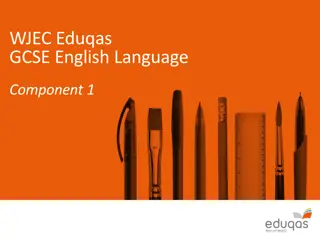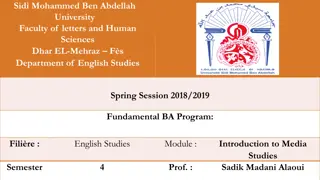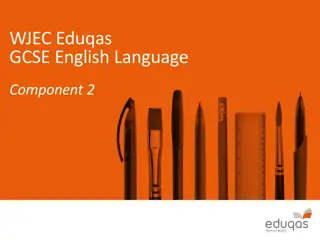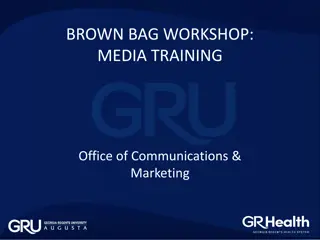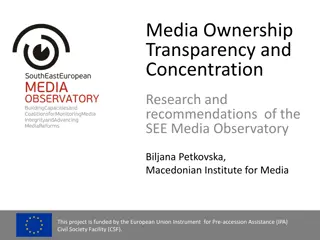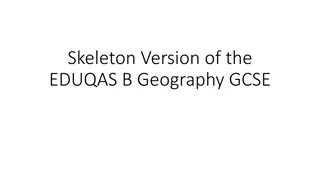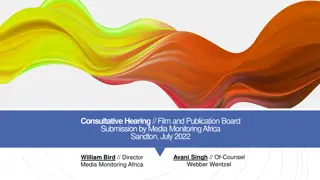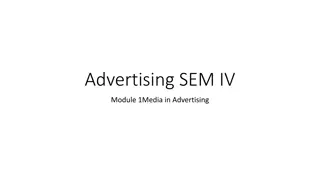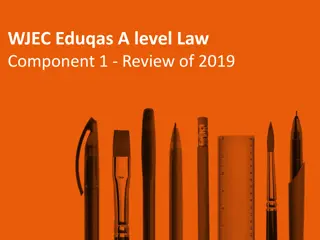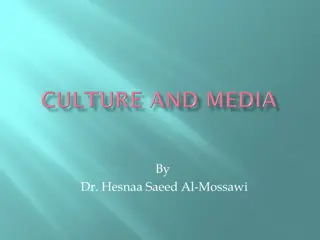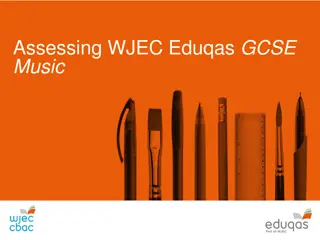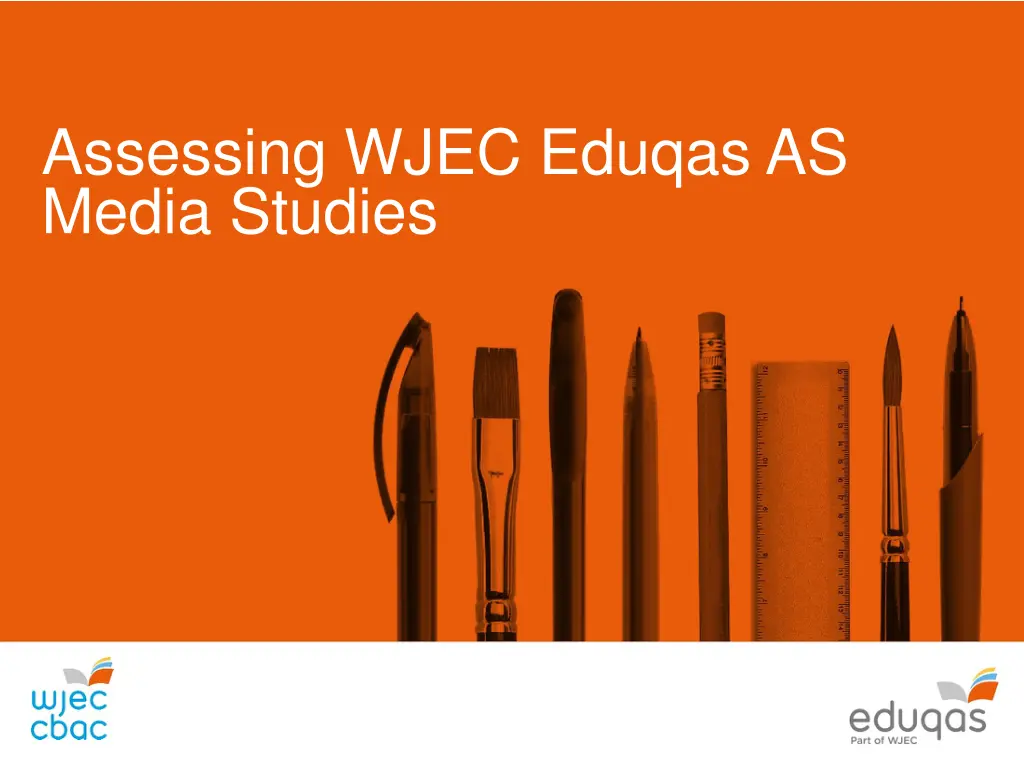
Understanding Effective Student Assessment in Media Studies
Explore the importance of objectivity in assessing student responses in media studies, covering strategies for ensuring fair evaluation, understanding assessment criteria, and utilizing marking schemes effectively. Gain insights into formative vs. summative assessments and optimizing assessment processes for optimal learning outcomes.
Download Presentation

Please find below an Image/Link to download the presentation.
The content on the website is provided AS IS for your information and personal use only. It may not be sold, licensed, or shared on other websites without obtaining consent from the author. If you encounter any issues during the download, it is possible that the publisher has removed the file from their server.
You are allowed to download the files provided on this website for personal or commercial use, subject to the condition that they are used lawfully. All files are the property of their respective owners.
The content on the website is provided AS IS for your information and personal use only. It may not be sold, licensed, or shared on other websites without obtaining consent from the author.
E N D
Presentation Transcript
Assessing WJEC Eduqas AS Media Studies
Assessing evidence It is important to ensure objectivity in assessing students responses, both at the initial marking stage and during internal standardisation. Do not allow personal knowledge of individual students to affect assessment decisions: ensure that you mark the student responses in front of you rather than the students behind them. JCQ has provided training on ensuring objectivity when assessing students evidence. You should also consider the purpose of the assessment, particularly if you are selecting evidence which has been completed earlier in the course. Formative assessment, conducted during the course of the learning in order to gauge student understanding, may not always provide appropriate evidence, as the student may not have fully developed their understanding of all concepts to the best of their ability at this point in time. Summative assessment, either at the end of the course or the end of a component may provide a more realistic picture of the students attainment levels.
Assessing evidence Understanding the assessment criteria Assessment criteria generally take two forms: objective marking generally for low tariff responses, where knowledge of objective information is being assessed the exercising of academic judgement via: an assessment grid setting out criteria for different levels of response indicative content, that is, an indication of the kind of content responses may include.
Assessing evidence Understanding the assessment criteria exercising academic judgement through levels of response mark schemes Firstly, identify the appropriate band a student s response falls into according to the criteria. Award a band where the student s response covers the majority of the criteria. Secondly, consider a mark in the centre of the band and then increase or decrease the mark depending on the quality of the answer, which may be reflected in the amount of indicative content covered. If a response falls between two bands, consider whether there are more characteristics of the higher or lower of the two bands and award accordingly. Indicative content is not exhaustive and other valid responses may be credited.
Assessing evidence Understanding the assessment criteria centre-devised assessments Teachers should, wherever possible, use the levels of response marking schemes that we have provided in the assessment responses as a starting point for assessing students. Indicative content in Eduqas marking schemes can be used as a guide to the types of skills and knowledge expected for the unit. Indicative content relevant to the centre-devised task will need to be provided by the teacher to accompany the levels of response marking schemes to support internal standardisation and any possible appeals.
Assessing evidence Rubric infringements WJEC Eduqas has a consistent way of addressing rubric infringements. Below is a list of the possible infringements which sometimes occur for this qualification. Type of infringement Action Where the correct answer has been clearly crossed out. If the student writes and then crosses out the correct answer, do not award the mark, even if no other answer is offered. Incorrect numbering of an answer If it is obvious which question is being answered, award marks as per the marking scheme for the question focused on by the student. If there is creditworthy material relevant to both questions 7 and 8, for example, under question 8, award marks for the question 8 and where possible consider additional information for question 7 if question 7 has not been attempted. Do not double credit for both question 7 and 8.
Assessing WJEC Eduqas ASMedia Studies Component 1
Assessing evidence Assessment Purpose Component 1 addresses the following assessment objectives (AOs): AO1 Demonstrate knowledge and understanding of: the theoretical framework of media contexts of media and their influence on media products and processes. AO2 Apply knowledge and understanding of the theoretical framework of media to: analyse media products, including in relation to their contexts and through the use of academic theories make judgements and draw conclusions.
Assessing evidence Assessment Criteria Qualitative Descriptor Amplification AO1 Detailed and accurate knowledge and understanding of the theoretical framework of media Detailed and accurate knowledge and understanding of contexts of media and their influence on media products and processes Band 5 - Excellent AO2 Perceptive analysis of media products, including in relation to their contexts Perceptive use of academic theories where relevant Judgements and conclusions are perceptive and fully supported
Assessing evidence Assessment Criteria Qualitative Descriptor Amplification AO1 Secure knowledge and understanding of the theoretical framework of media Secure knowledge and understanding of contexts of media and their influence on media products and processes Band 4 - Good AO2 Logical analysis of media products, including in relation to their contexts Logical and coherent use of academic theories where relevant Judgements and conclusions are logical, coherent and well supported
Assessing evidence Assessment Criteria Qualitative Descriptor Amplification AO1 Generally sound knowledge and understanding of the theoretical framework of media Generally sound knowledge and understanding of contexts of media and their influence on media products and processes Band 3 - Satisfactory AO2 Reasonable and straightforward analysis of media products, including in relation to their contexts Reasonable and straightforward use of academic theories where relevant Judgements and conclusions are reasonable and supported in a straightforward manner
Assessing evidence Assessment Criteria Qualitative Descriptor Amplification AO1 Partial knowledge and understanding of the theoretical framework of media Partial knowledge and understanding of contexts of media and their influence on media products and processes Band 2 - Basic AO2 Undeveloped analysis of media products, including in relation to their contexts (there may be a tendency to simply describe) Basic or undeveloped use of academic theories where relevant Judgements and conclusions are basic, undeveloped and only partially supported
Assessing evidence Assessment Criteria Qualitative Descriptor Amplification AO1 Little or no knowledge and understanding of the theoretical framework of media Little or no knowledge and understanding of contexts of media and their influence on media products and processes Band 1 - Minimal AO2 Superficial and generalised analysis of media products, including in relation to their contexts Superficial and generalised use of academic theories, if used at all Judgements and conclusions are superficial, generalised and lacking supporting evidence
Assessing evidence Characteristics of a successful response Clear and consistent engagement with the question and its specific focus, for example addressing how far or the impact of Meaningful engagement with the theoretical framework of the subject (e.g., purposeful use of subject-specific concepts and academic theories where relevant) Clear and appropriate reference to specific aspects of the set product(s) to support the points made Meaningful links drawn between contexts of media and media products (where relevant) Clearly structured, fluent and coherent (for extended response questions)
Assessing evidence Characteristics of a less successful response Failure to clearly and consistently address the specific requirements of the question A lack of engagement with the theoretical framework of the subject or inclusion of theory simply for inclusion s sake (i.e., without relevance or purpose) Limited or more generalised supporting reference to the set product(s) Links between contexts of media and media products not drawn or tenuous (where relevant) Poorly structured and not coherent (for extended response questions)
Assessing evidence POTENTIAL PROBLEM AREAS / WHAT NOT TO REWARD Some questions are particularly difficult to mark. This is because learners may respond in ways that are unexpected. It is vitally important, therefore, that all responses are judged on individual merit. It is also worth emphasising that the indicative content in the marking schemes is indicative rather than prescriptive and should not be treated as a definitive checklist of content that learners must include. When assessing the quality of a learner s response, it should be judged against the relevant Assessment Objectives and the criteria identified in the assessment grid. References to academic theories should only be credited where they are used appropriately and with purpose, not when they are simply included for inclusion s sake. How relevantly the theory is used and how effectively it is applied should always be considered.
Assessing WJEC Eduqas AS Media Studies Component 2
Assessing evidence Assessment Purpose Component 2 addresses the following assessment objectives (AOs): AO1 Demonstrate knowledge and understanding of: the theoretical framework of media contexts of media and their influence on media products and processes. AO2 Apply knowledge and understanding of the theoretical framework of media to: analyse media products, including in relation to their contexts and through the use of academic theories make judgements and draw conclusions.
Assessing evidence Assessment Criteria Qualitative Descriptor Amplification AO1 Detailed and accurate knowledge and understanding of the theoretical framework of media Detailed and accurate knowledge and understanding of contexts of media and their influence on media products and processes Band 5 - Excellent AO2 Perceptive analysis of media products, including in relation to their contexts Perceptive use of academic theories where relevant Judgements and conclusions are perceptive and fully supported
Assessing evidence Assessment Criteria Qualitative Descriptor Amplification AO1 Secure knowledge and understanding of the theoretical framework of media Secure knowledge and understanding of contexts of media and their influence on media products and processes Band 4 - Good AO2 Logical analysis of media products, including in relation to their contexts Logical and coherent use of academic theories where relevant Judgements and conclusions are logical, coherent and well supported
Assessing evidence Assessment Criteria Qualitative Descriptor Amplification AO1 Generally sound knowledge and understanding of the theoretical framework of media Generally sound knowledge and understanding of contexts of media and their influence on media products and processes Band 3 - Satisfactory AO2 Reasonable and straightforward analysis of media products, including in relation to their contexts Reasonable and straightforward use of academic theories where relevant Judgements and conclusions are reasonable and supported in a straightforward manner
Assessing evidence Assessment Criteria Qualitative Descriptor Amplification AO1 Partial knowledge and understanding of the theoretical framework of media Partial knowledge and understanding of contexts of media and their influence on media products and processes Band 2 - Basic AO2 Undeveloped analysis of media products, including in relation to their contexts (there may be a tendency to simply describe) Basic or undeveloped use of academic theories where relevant Judgements and conclusions are basic, undeveloped and only partially supported
Assessing evidence Assessment Criteria Qualitative Descriptor Amplification AO1 Little or no knowledge and understanding of the theoretical framework of media Little or no knowledge and understanding of contexts of media and their influence on media products and processes Band 1 - Minimal AO2 Superficial and generalised analysis of media products, including in relation to their contexts Superficial and generalised use of academic theories, if used at all Judgements and conclusions are superficial, generalised and lacking supporting evidence
Assessing evidence Characteristics of a successful response Clear and consistent engagement with the question and its specific focus, for example addressing how far or the impact of Meaningful engagement with the theoretical framework of the subject (e.g., purposeful use of subject-specific concepts and academic theories where relevant) Clear and appropriate reference to specific aspects of the set product(s) to support the points made Meaningful links drawn between contexts of media and media products (where relevant)
Assessing evidence Characteristics of a less successful response Failure to clearly and consistently address the specific requirements of the question A lack of engagement with the theoretical framework of the subject or inclusion of theory simply for inclusion s sake (i.e., without relevance or purpose) Limited or more generalised supporting reference to the set product(s) Links between contexts of media and media products not drawn or tenuous (where relevant)
Assessing evidence POTENTIAL PROBLEM AREAS / WHAT NOT TO REWARD Some questions are particularly difficult to mark. This is because learners may respond in ways that are unexpected. It is vitally important, therefore, that all responses are judged on individual merit. It is also worth emphasising that the indicative content in the marking schemes is indicative rather than prescriptive and should not be treated as a definitive checklist of content that learners must include. When assessing the quality of a learner s response, it should be judged against the relevant Assessment Objectives and the criteria identified in the assessment grid. References to academic theories should only be credited where they are used appropriately and with purpose, not when they are simply included for inclusion s sake. How relevantly the theory is used and how effectively it is applied should always be considered.
Any Questions? If you have any questions, contact our specialist subject officers and administrative support team for your subject with any queries. media@eduqas.co.uk



